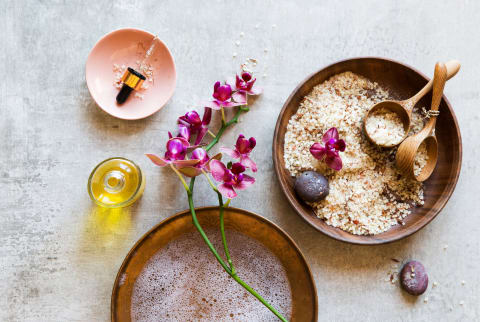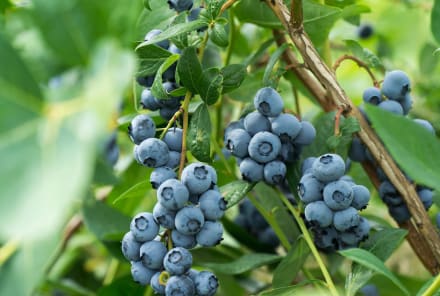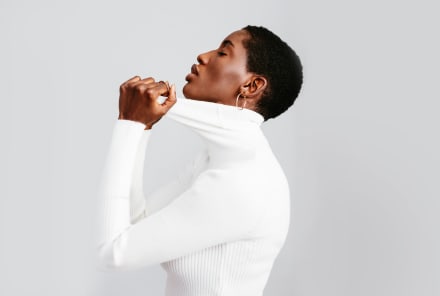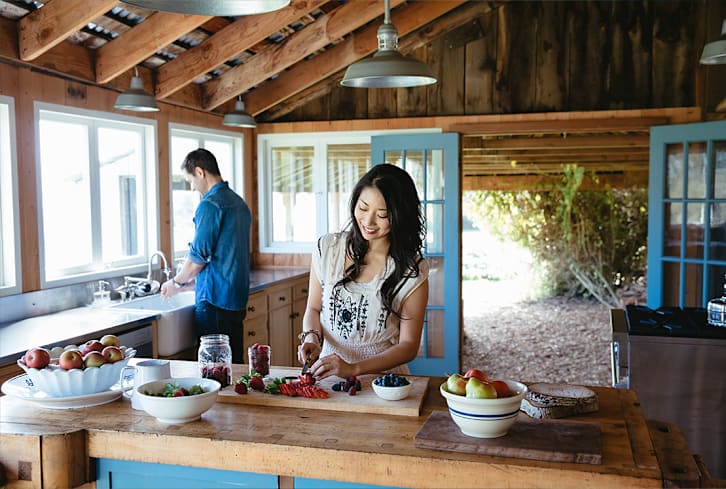Advertisement
What You Need To Know About Aromatherapy & 9 Essential Oils To Get Started


Many people know aromatherapy simply as the mixture of pleasing scents that accompany a relaxing day at the spa. We've got nothing against the soothing smells associated with a massage, but aromatherapy actually brings so much more to the table in terms of natural, holistic ways to boost physical and mental health.
What is aromatherapy?
Aromatherapy, or essential oil therapy, is a form of holistic healing using essential oils and natural plant extracts. Many people consider it both an art and a science that creates emotional, spiritual, psychological, and physical balance via natural botanicals. Professional aromatherapists are trained extensively on the medicinal qualities of each oil and how its healing properties can be used to address a range of needs.
The history of aromatherapy and essential oils is said to date back to Mesopotamia. It was utilized by ancient cultures in Egypt, India, China, and beyond. The method of modern distillation was discovered by a Persian physician who lived between 980 and 1036 C.E., and according to historical reports, he was the first to distill rose essential oil.
By the 16th century, aromatherapy and essential oils were recognized around the globe as a form of alternative medicine. The term "aromatherapy" was eventually coined by French perfumer Rene-Maurice Gattefosse in 1937 when he published a book with some of the first clinical findings regarding the medicinal and healing properties of essential oil therapy. Today, there is a huge global market for aromatherapy and essential oils, and aspiring professional aromatherapists can receive training with help from organizations like the National Association for Holistic Aromatherapy.
What are the benefits of aromatherapy?
The benefits of holistic aromatherapy range from physical to emotional to psychological. Scientific studies have proved that aromatherapy can help treat a wide range of ailments.
1. It can promote relaxation and improve sleep.
One of the most widely used essential oils in aromatherapy is lavender, which has been linked to a reduction of migraine1 and depression symptoms2, and improved sleep quality3 when inhaled (either directly or by way of topical application to the body with a carrier oil). Ylang-ylang4, another popular essential oil, has also been associated with relaxation and improved mood after topical application.
2. It can help alleviate allergies.
Got the seasonal sniffles? Aromatherapy can help with that, too. "I love essential oils because they are easy to carry around, and they can help your allergy symptoms," Taz Bhatia, M.D., integrative medicine physician, told mbg. "The combination of peppermint, lavender, and lemon essential oils acts as a natural antihistamine and stops the inflammatory response associated with allergies. Mix the three together and diffuse in your bedroom or workspace."
3. It can help pain management.
Breathing in beneficial essential oil compounds also holds promise for combating pain, with research showing5 that patients with arthritis reported less pain and improve mood after topical application of lavender, marjoram, eucalyptus, rosemary, and peppermint essential oils blended with a carrier oil. Similarly, a combination of clary sage, marjoram, cinnamon, ginger, and geranium essential oils in a base of almond oil was found to6 alleviate menstrual pain in women when massaged onto the abdomen.
4. In some cases, it's been used to treat addiction.
In one study7, smokers who were trying to quit experienced fewer cravings for cigarettes and withdrawal symptoms after inhaling black pepper essential oil as compared to those who inhaled menthol.
The most popular essential oils for aromatherapy.
The list of essential oils used for aromatherapy could fill the length of a CVS receipt. But these are a few of the most popular and versatile options that will likely provide the most bang for your buck (essential oils can be pricey, after all!):
- lavender oil (calming, mood lifting)
- peppermint oil (invigorating, promotes focus)
- tea tree oil (immune boosting, antimicrobial)
- lemon oil (energizing, mood lifting)
- rose oil (mood lifting, libido enhancing)
- ylang-ylang oil (relaxing, mood lifting)
- cinnamon oil (mood lifting, libido enhancing)
- eucalyptus oil (cooling, energizing)
- black pepper oil (quells anxiety and cravings)
How to use essential oils for aromatherapy.
Essential oils can be used in aromatherapy either topically or indirectly via a diffuser, spray bottle, or other accessory or device.
Inhalation and diffusion
Inhalation is one of the easiest ways to use essential oils in your home. You can use a diffuser, mix a few drops with water in a spray bottle, sprinkle oils on the shower floor so they're carried up with the steam, or drop them into a tissue and inhale them. You can even purchase necklaces and bracelets featuring porous lava beads onto which you add a few drops of your favorite essential oil to enjoy throughout the day— the heat from your skin helps spread the scent!
Topical application
Applying essential oils topically is a great way to reap their aromatic benefits wherever you go—and in some cases relieve pain and inflammation. But most essential oils are far too caustic to be applied directly to the skin. One well-known way to avoid irritating the skin with essential oils is to use a carrier oil, like coconut oil or jojoba oil. Carrier oils are typically neutral-smelling oils that are used to dilute essential oils to safe levels so they do not cause skin irritation—this does not, however, dilute their therapeutic perks.
The typical ratio of essential oil to carrier oil is 3 drops essential oils to 2 teaspoons of carrier oil for facial application, and up to 6 drops essential oils to 2 teaspoons of carrier oil for application to areas like the arms, legs, and stomach.
One exception to the carrier oil rule is lavender essential oil (when used as a spot treatment, not when used on larger sections of skin). There is evidence to support the use of lavender essential oil as an analgesic8 (pain reliever), anti-inflammatory9, and topical antibiotic10, making it handy for burns and bug bites.
Aromatherapy and essential oil side effects.
As with any type of treatment or holistic remedy, it's important to be aware of potential risks or unwanted effects. Certain essential oils are more likely to cause irritation than others, even when diluted with a carrier oil, such as oregano, cinnamon, and clove, due to their higher concentration of natural chemical compounds that can be irritating to the skin. There are also certain oils that you should keep out of your bathtub such as black pepper, oregano, camphor, and hyssop (find the full list here).
If you're pregnant, you should be extra careful with essential oils, especially when using them topically. The National Association of Holistic Aromatherapy warns that this is a somewhat murky area and that the lack of research and the risk of potential toxicity may mean it's best to avoid essential oils altogether or at least consult with your health care provider about which essential oils are likely safest and in what ways you can use them.
So, should you try aromatherapy?
Aromatherapy is an ancient holistic treatment that has been shown to help alleviate a vast array of different symptoms and conditions from depression to PMS cramps. It's even been seen used in Western medical settings like this emergency room, where nurses had patients breathe in a blend of peppermint, lavender, ginger, and spearmint oils to combat nausea and vomiting.
Essential oils are easy to use safely at home (as long as you remember to dilute!) and even better with the guidance of a professional aromatherapist, esthetician, or masseuse who can recommend specific essential oils or blends for specific ailments you want to address. If you're looking for a natural, botanical remedy, there's little harm in experimenting with aromatherapy—as long as you take the necessary precautions.
10 Sources
- https://www.ncbi.nlm.nih.gov/pubmed/22517298
- https://www.ncbi.nlm.nih.gov/pubmed/16520572
- https://www.ncbi.nlm.nih.gov/pubmed/16131287
- https://www.ncbi.nlm.nih.gov/pubmed/16807875
- https://www.ncbi.nlm.nih.gov/pubmed/15778570
- https://www.ncbi.nlm.nih.gov/pubmed/21949670
- https://www.ncbi.nlm.nih.gov/pubmed/8033760
- https://www.ncbi.nlm.nih.gov/pubmed/22196577
- https://www.ncbi.nlm.nih.gov/pubmed/26247152
- https://www.ncbi.nlm.nih.gov/pubmed/19249919

















